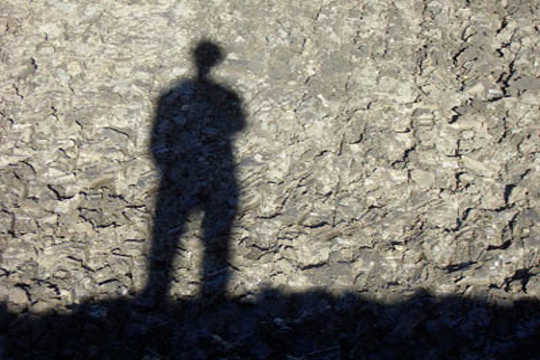
According to Jung, the shadow is any part of the psyche which remains unconscious. It is not always dark or undesirable. Since the shadow is any part of ourselves that we "send away," it contains material that is both constructive and destructive.
I am frequently asked to explain the difference between the shadow and the dark side. The distinction is really quite simple in that everyone has a dark side which she/he may or may not be aware of. That part of the dark side of which one is not conscious lives in the shadow, along with parts of oneself which may also be quite pleasing, yet for one reason or another, are allowed neither awareness nor expression.
The other half of the dark side lives in our awareness -- those demons or personal foibles of which we are conscious, and while they may haunt or embarrass us, nothing is more formidable than the darkness of which we are not aware. Thus, we say that it remains in the shadow, dwelling unseen by an ego which insists that certain thoughts and behaviors which we cannot bear to acknowledge are "not me."
I have addressed the issues of darkness and forgiveness primarily in relation to individuals. Nevertheless, communities, nations, and cultures have their own darkness and, of course, their own shadows. As with individuals, the more affluent, powerful, and self-sufficient a nation or culture is, the greater its resistance to recognizing its shadow.
THE SHADOW ERUPTS IN AMERICA
The 1960s in the United States was a time of shadow emergence for a culture smugly ensconced in having won a world war and delirious with the materialism of the fifties. The bohemian writers and artists of the late fifties gave birth to a generation of noisy dissidents who made famous such obscure places as Berkeley, Selma, and Kent State. For nearly a decade, the previously-unacknowledged malignancies of racism, sexism, the military-industrial complex, and a plethora of societal hypocrisies erupted so relentlessly and so tumultuously that the fabric of American culture began rapidly unraveling. While it was a riveting time for young mavericks like myself, zealously savoring intellectual and social transmutation, it was also an era of exhaustion. The unveiling of the shadow is always burdensome and frequently unbearable, as I believe it proved to be for America at the end of the sixties.
The Vietnam War, the assassinations of John and Bobby Kennedy and Martin Luther King, the conflagration of the 1968 Democratic Convention in Chicago, and the Tet Offensive in Vietnam which gave rise to Lyndon Johnson's decision not to seek a second term in office, as well as Richard Nixon's determination to bomb Cambodia, brought to a head a configuration of social and political forces in early 1970. For the first time, at an unrenowned university in Ohio, students were shot and killed during a peaceful demonstration against the policies of the United States in Southeast Asia. In a matter of weeks, however, a majority of those engaged in protest quietly receded in disappointment, spelling of cynicism, and despair. Suddenly, the gravel-throated strains of Janis Joplin and Grace Slick gave way to the more pensive tunes of Carole King and James Taylor, ultimately deteriorating into the mushy melodies of Karen Carpenter and Bread.
John Lennon released his first solo album which sounded as if it had been marinated in rage, yet sorrowfully announcing that "the dream is over," the dream of cultural and social transformation which the Beatles had been pivotal in creating. Then, as if echoing an entire generation, Lennon sang primarily of himself telling us that the only thing that matters is "me -- Yoko and me." With the dawn of the 1970s, the youth of America fled from the streets and into the ashrams, no longer preferring the militant lyrics of groups like the Jefferson Airplane singing "Volunteers Of America," but rather etheral, other-worldly words and music like Norman Greenbaum's "Spirit In The Sky."
THE SHADOW RECEDES
Not only were the sixties over, but so was the blatant eruption of America's shadow. Journalists and social commentators analyzing the first six months of 1970 concur that the protest generation was exhausted. Remaining in the melee had become too costly, too taxing to seem worth it any longer. Shortly thereafter, three enormous icons of the sixties' cacophony succumb to the drugs that they assured us would open minds and change the world. The deaths of Janis Joplin, Jimi Hendrix, and Jim Morrison evoked further retreat from protest and sent the Woodstock Nation on its way to shaping what has become unquestionably the most narcissistic culture in the history of the world.
It is hardly surprising then, that with the subsiding of noisy, messy social criticism in the seventies, the culture became mesmerized with tranquilizing spiritual techniques and myriad paths to enlightenment. Tragically, the theme song of the last two decades has been "me and my journey," rather than "me and my shadow" or more accurately, "me, my culture, and the shadow".
But as Jung reminds us, when disowned, the shadow does not become extinct but rather ultimately and invariably reveals itself with ever more ferocity and stealth. America is now paying the price for being unable to tolerate the agony of confronting its shadow in the early seventies. Each time the shadow is disowned and the external situation appears to improve, we become more seduced by the illusion that the shadow does not exist, and therefore, the difficulty of confronting it multiplies a thousandfold. Nothing is more inimical to shadow awareness than prosperity, success, comfort, and power. While such qualities are not inherently undesirable, they can impede consciousness if one is not committed to it above all else. Thus, we can only speculate where our culture, now seemingly thoroughly deluded about its shadow, is headed. How dire must our predicament become before we turn our attention again to the shadow that never went away?
All nations perceive themselves from time to time as victims of other nations, yet the United States is probably the least qualified nation on earth to claim the victim status. Even a casual exploration of the American shadow reveals the genocide of native peoples; the burning of witches; a robust economic base built on the backs of slaves; economic and military imperialism around the globe; the manufacture and detonation of the first atomic bomb; the Vietnam War, attended by massive deception and cover up; Kent State; Watergate; Iran-Contra; the S & L debacle; Tailhook; Oklahoma City; Columbine; Matthew Shepard; James Bird. The United States is in desperate need of forgiveness, yet until its transgressions are owned, forgiveness is not possible.
While it is true that President Clinton apologized publicly to Native Americans for the nation's crimes against them in past generations, words are only the beginning of restitution. On August 6, 1995, fifty years after Hiroshima and Nagasaki, Japan requested an apology from the United States for dropping the atomic bomb, but President Clinton and Congress declined. This raises the issue of redress and how America might assume responsibility for its transgressions. If America were to own its shadow, how could it experience forgiveness?
THE SOUL OF COLLECTIVE REPENTANCE
Again, thinking mythologically, we have the example of the Old Testament in which the scapegoat (an actual goat) was used as a sacrificial offering to atone for the sins of the community. American history is replete with examples of creating false scapegoats for its offenses, rather than acknowledging the offenses. But if our nation were to become accountable, what would a "national sin offering" look like in a culture that prefers to throw money at the messes it creates rather than participate in cleaning them up. Ironically, Americans seem to be driven by a sense of moral consciousness and purport to have developed it far beyond the moral consciousness of any other nation on earth. But this very "moral consciousness," I believe, is largely responsible for our inability to acknowledge the American shadow. What we need is not more moralism, not more spiritedness, and definitely not more therapeutic, talk-show psychobabble. Rather, we need to face our plight mythopoetically, that is, by exploring our story as a nation -- where it has been and where it is going -- symbolically, mythically utilizing poem and ritual, not merely more analysis.
One of the most mythopoetically dynamic locations in the United States is the Vietnam War Memorial. At "the wall," the senses are fully engaged as people see and touch the names of the dead, and as the sound of weeping and the wind in the trees pierces the fallacies of "the just war."
At the wall, denial ends, and the slaughter and covert madness of the war's architects shatter our illusions that we have somehow evolved beyond the so-called incivility of the ancients. At the wall, the soul of America writhes in remorse and the humbling reminder of the savage collective myths all humans have played out -- from the caveman's club to the concentration camps of the Third Reich.
Still another site of ritual and repentance is the Oklahoma City Memorial, the bloodbath occurring there in April, 1995 a gruesome reminder that some events cannot be cured, erased, resolved, or put behind us. Some six years later, most of the survivors of the explosion now acknowledge that they will never be whole -- that something was permanently taken from them on that day that is gone forever. Their memorial stands not only as a monument to the 1995 tragedy but to the mythic essence of all grief and loss.
A national sin offering might begin with slowing down our frenetic lifestyle as our President mandates a national day of mourning in which stores and stock exchanges are closed, television networks (without commercials) are focused only on the loss, and quiet rituals, not noisy, festive parades, are created in every town and neighborhood of America. Spiritual advisors from indigenous religions could be consulted and invited to perform grief rituals in places where shooting sprees and other trauma have occurred. More memorials might be built by the various communities that have been oppressed, such as the construction and circulation of the AIDS Quilt by the gay and lesbian community in the eighties and nineties.
A network of Native American tribes might construct a large memorial in the center of the country which would become not only a monument but a shrine -- a sacred place where members of the community could pray and share in rituals of healing. With the support of concerned parents, children who have been victimized by public trauma and private abuse could construct a national memorial/shrine honoring wounded children and providing a sacred place to pray for their wellbeing.
While these options for a national sin offering may sound too passive, too simplistic, or too esoteric, they suggest a perspective and a pathway that has not been explored -- an approach that does not legislate or finance superficial quick fixes, but rather descends beneath the national ego to the mythic, symbolic level where Americas shadow has been banished. It acknowledges that the homeless are homeless not only because they are unemployed and often mentally ill or drug-addicted, but that the culture has been pre-occupied with marginalizing the outcasts -- exiling those who remind us of parts of ourselves that we cannot bear to see.
The mythic perspective recognizes that children kill as a result of their rage towards us for disowning the child in ourselves, that their innocence and vulnerability terrify and repel us and that they are dying of the consumerism we have fed them in order to avoid hearing their real needs -- needs we have no idea how to meet because we have become so pathetically, dreadfully empty. Reading the symbols of America's violence epidemic, we see that although guns are cherished as sacred in our culture and our constitution, and although there some five hundred guns for every American citizen, neither gun control nor gun extinction can remedy the rage and cynicism that have made verbal abuse, rudeness, and bullying both trendy and synonymous with sophistication.
In a culture that refuses to reflect upon itself and cannot tolerate human encounters more profound than the banalities exchanged in shopping malls and chat rooms, only radical ritual, in my opinion, can engender epicenters of consciousness that reverberate into the radius of an anesthetized, consumeristic, technologically-obsessed culture. Like the infant Moses, the modern world drifts down the river of materialism in what may result unequivocally in the extinction of the species, or may, by some act of inexplicable grace, ultimately precipitate an "exodus" from the contemporary "pharaohs" of unbridled reason and voracious technological conquest of the ecosystems -- a testimony to the fragility and unpredictability of the destinies of individuals and cultures who open the door of forgiveness.
This article is excerpted from:
 The Journey of Forgiveness
The Journey of Forgiveness
by Carolyn Baker, Ph.D.
Reprinted with permission of the publisher, Authors Choice Press. ©2000. www.iuniverse.com
Info/Order this book
About the Author
Carolyn Baker, Ph.D. is a storyteller, drummer, and educator living on the Mexican border of the Southwestern United States. She leads workshops and retreats on ritual and mythology of which she has been a lifelong student. She is author of RECLAIMING THE DARK FEMININE.. The Price of Desire as well as of The Journey of Forgiveness.
Related Books:
at InnerSelf Market and Amazon


























